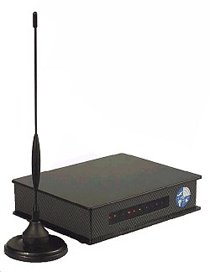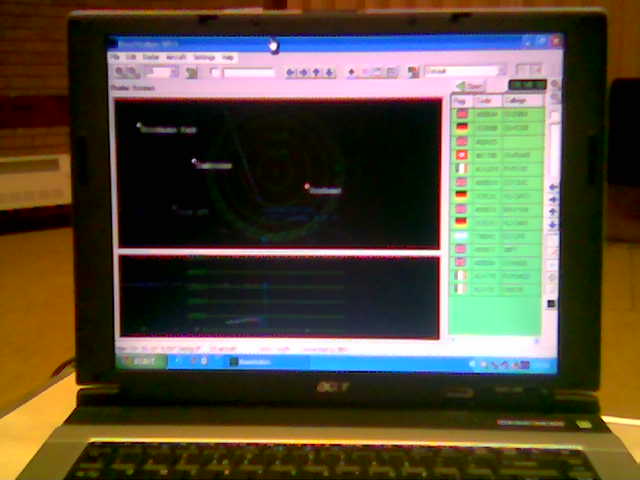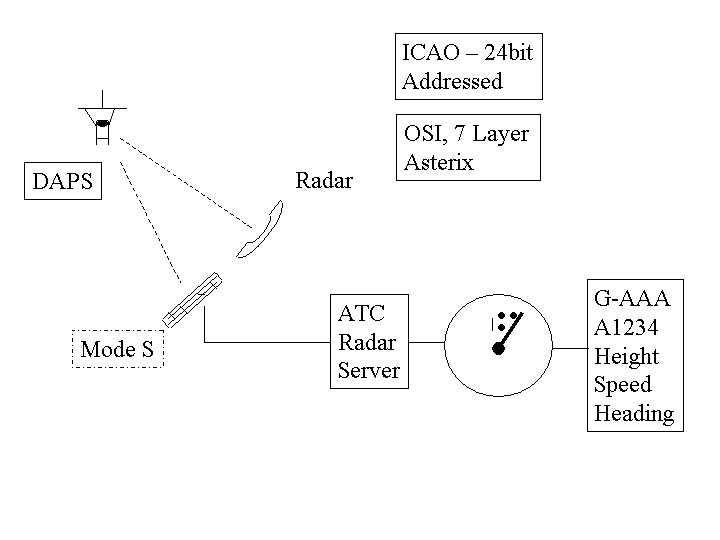 The manufacturers claim:
The manufacturers claim:
Combining state-of-the art electronics and new technological advances has enabled Kinetic Avionic Products Limited to the produce the revolutionary SBS-1.
The SBS-1 is a portable low-cost Mode-S/ADS-B Receiving Station designed for training and the aviation enthusiast.
It is supplied complete with antenna, power supply and Basestation Virtual Radar software. The SBS-1 allows you to track ADS-B aircraft on the radar screen and identifies and displays Mode-S equipped aircraft.
Further info follows at the bottom of this page.
 Mike demonstrated this inexpensive (£500) and sophisticated piece of equipment
and explained that after 2006 all commercial aircraft will have to have a mode S transponder installed,
after 2008, ALL aircraft flying in controlled airspace will have to have a transponder too.
Mike demonstrated this inexpensive (£500) and sophisticated piece of equipment
and explained that after 2006 all commercial aircraft will have to have a mode S transponder installed,
after 2008, ALL aircraft flying in controlled airspace will have to have a transponder too.
These transponders operate at 1030MHz Uplink, and 1090MHz for the downlink.
Each transponder has a unique address, that is registered to the aircraft. and this device is capable of transmitting numerous fields of information to the receiving station, these include:
Registration, Speed, Height, Heading, amongst others.

For enthusiasts who haven't got 500 quid to spend on such a whizzy gizmo, then a very cheap alternative is to obtain a copy of Win-ACARS, and connect their PC to a handheld tuned to 132.172MHz
Further Info:
The SBS-1 is a receiver for Mode-S/ADS-B beacons of commercial airliners, sent on 1090MHz. This beacon transmits data like position, flight level, identification and other information of the aircraft. With the supplied software the received data is displayed on the PC in tabular and graphic format, showing the current traffic situation of the region. The max. distance up to which an aircraft can be monitored is approx. 400km, but is strongly influenced by local circumstances like obstructions etc. The SBS-1 is connected to the PC with an USB cable, i.e. the computer must support USB (1.1 or 2.0). A version with Ethernet is in preparation. The supplied software works with most Microsoft Windows™ OS from Windows 98SE (second edition) up. According to the manufacturer the support of USB interfaces was limited and incomplete with Win98SE, so there might be problems installing the required drivers. Earlier versions of Windows and other OS are not supported at the moment.
The antenna connector on the SBS-1 is BNC, the supplied antenna comes with 5m cable. Others antennas can be used as long as they are suitable for 1090MHz, e.g. scanner antennas like discones or the Diamond D-707 active antenna. The supplied magnet base antenna performs best when installed on a metallic surface. The received data is displayed in tabular and graphical format. The table shows identification, nationality, callsign, position, ground speed, heading, rate of ascend/descend etc. The graphical map displays the position and tracks of aircraft together with selected data for each a/c. Descents/Ascents are coloured differently, representing an up to date situation of the regional airspace. Various zoom levels allow detailed display of smaller regions, e.g. a nearby airport. An elevation view shows the vertical movements of tracked a/c. The map also displays country boundaries and coastlines as well as waypoints, cities, airports etc. The these waypoints are stored in a simple text file format and can be easily extended.